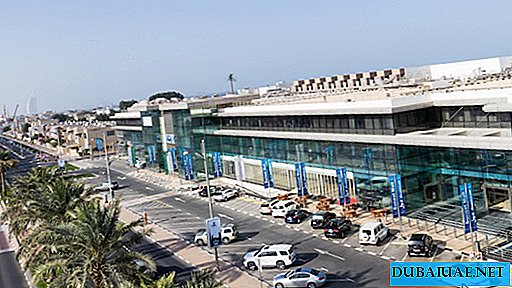TODAY IS ONE LOOK AT THE MAP OF THE UNITED ARAB EMIRATES AND A QUICK FAMILY WITH INDICATORS OF STATISTICS It is enough to understand where the capital of the UAE is. The Emirate of Abu Dhabi, together with the Administrative Center, occupies the lion's share (86.7%) of the territory of the state, about 40% of its population live in it, and 90% of it is covered under the earth and water. Abu Dhabi produces more than half the GDP of the entire state.
One of the approximately 200 islands of the emirate - Umm An Nar - gave the name to an ancient culture located on the territory of modern UAE in the Bronze Age 4-4.5 thousand years ago. In the city of Abu Dhabi are all government agencies of the state.
The closest “pursuer” - Dubai, the largest city in the UAE, a pioneer of innovative development and a visiting card of the Emirates in the minds of many people - cannot yet qualify for the official championship. Once, the author of these lines, amazed by the Dubai miracles and hardly believed in the possibility of seeing something more, was surprised by a random conversation between people doing business in the UAE. One of them explained to another that in Dubai, of course, it’s good to do business, but really big bets are made in Abu Dhabi.
Subsequently, more than once I heard confirmation of these words, including from Russian businessmen. Nevertheless, if we take a closer look at the history of the Emirates, we find that Abu Dhabi did not always hold the palm. Over the centuries of the history of these lands, one or the other city has come to the forefront, occupying a central position in a particular area.
Until now, almost every emirate has something to brag about to the rest. Often the lands of future UAE were ruled from abroad. Finally, like mirages over red-hot dunes, there were even projects to create a new capital in the uninhabited areas of the desert. Being castles in the sand, these plans could not stand the clash with reality, however, as we will see, reality itself in the future can surpass one bold idea of the past.
In pre-Islamic times, the Persian Sassanid dynasty dominated the historical lands of Oman. The main shopping center on the coast was the Dibba region, which today is divided between the emirates of Fujairah and Sharjah in the UAE, as well as Oman. After the spread of Islam in the 7th century, they did not forget about the significance of Dibba: merchants from all over Arabia, from India and even China flocked to the annual trade fair there.
 With the advent of Islam, Oman began to be ruled by representatives of the caliphs. So, in the reign of the second caliph Omar ibn Al Khattab, these lands were led by an official who was appointed by the wali (ruler) of the Iraqi city of Basra. Vali themselves, in turn, were chosen in the capital of the Caliphate - Medina. At the next caliph, Osman Ibn Al-Affan, the Omani lands received their own vali. However, in the era of the Umayyad dynasty, from 661 to 750, the Omar system was again restored. Already in the late Umayyads, trends began to emerge, which later led to the fragmentation of the lands of Oman. In particular, the Ibadite sect appeared. Its members will subsequently elect their own imams in the internal lands of Oman, formally governed from the capital of the Caliphate. This situation also occurred under the early representatives of the new Caliph dynasty - the Abbasids. In the early 900s, legendary Karmatians create their own state on the lands of present-day Bahrain and Oman, which shocked the Islamic world with their raid on the holy Mecca with the abduction of black stone from the main Islamic shrine - the Kaaba. They controlled the coast for less than half a century. From the 11th century until 1616, the Ibadite states succeeded each other on the internal lands of Oman.
With the advent of Islam, Oman began to be ruled by representatives of the caliphs. So, in the reign of the second caliph Omar ibn Al Khattab, these lands were led by an official who was appointed by the wali (ruler) of the Iraqi city of Basra. Vali themselves, in turn, were chosen in the capital of the Caliphate - Medina. At the next caliph, Osman Ibn Al-Affan, the Omani lands received their own vali. However, in the era of the Umayyad dynasty, from 661 to 750, the Omar system was again restored. Already in the late Umayyads, trends began to emerge, which later led to the fragmentation of the lands of Oman. In particular, the Ibadite sect appeared. Its members will subsequently elect their own imams in the internal lands of Oman, formally governed from the capital of the Caliphate. This situation also occurred under the early representatives of the new Caliph dynasty - the Abbasids. In the early 900s, legendary Karmatians create their own state on the lands of present-day Bahrain and Oman, which shocked the Islamic world with their raid on the holy Mecca with the abduction of black stone from the main Islamic shrine - the Kaaba. They controlled the coast for less than half a century. From the 11th century until 1616, the Ibadite states succeeded each other on the internal lands of Oman.
The capital of the first of them was the city of Nizwa. The importance of Muscat, the center of Oman, grew. The coastal regions of Oman in the Persian Gulf depended more and more on the trading city of Hormuz on the northern shore. Together with the large port of Julfar, in the future emirate of Ras Al Khaimah, experiencing a rise since about 1300, this city controlled the Strait of Hormuz.
After 1500, the Portuguese imposed their domination in the Persian Gulf for a century and a half with fire and sword. Their possessions in the Indian Ocean will be managed by the Viceroy from his residence in Cochin, and after 1515 in Goa. Thus, the tradition of the colonial management of Omani lands from Europe through India, which the British continued, will be laid. They strengthened their control over the lands of future Emirates by the end of the eighteenth century. The British colonial administration was complex and resembled a layered cake. In 1820, the British crown forced the emirs and sheikhs of the seven Arab regions to sign the “General Agreement”, which marked the beginning of English domination in this territory and the final dismemberment of Oman into three parts - Imamat Oman, Sultanate of Muscat and “Pirate Coast” (since 1853 these lands have been generalized were called "Negotiated Oman"). From 1820 to 1949 a “local agent” was appointed to the sheikhs of Contract Oman, representing the interests of the crown. Ironically, not one of these agents was a local Arab - they were selected from Muslim Persians or immigrants from India. Local agents were accountable to a political resident who lived in the Iranian city of Bushehr.
He was responsible, in turn, first to the East India Company, in 1858-1873 to the branch of the British government in Bombay, and then to the government of British India. In 1934, another link appeared in the chain between the local agent and the political resident - the political agent, which was located in Bahrain.
After World War II, Great Britain made further changes to the management of Treaty Oman. Local agents were replaced by political agents in Treaty Oman, who were subordinate to a political resident. The latter moved from Bushehr to Bahrain. So, the lands of future UAE during the time of British domination were only the lower level of the colonial administrative pyramid, and their fate was decided in different foreign cities - close and distant.
Meanwhile, the role of the Omani sheikhs themselves during the time of British rule was changing. The island of Abu Dhabi was elected around 1760 as the residence of the Al Nahayanov clan from the Confederation of Bani Yas tribes, ruling today in Abu Dhabi. In the second half of the 18th century, the palace of the rulers of Qasr Al-Hisn ("The Castle Palace"), now turned into a museum, was erected on the island. At the same time, the main forces of the local tribes struggling with the penetration of the British did not concentrate at all in the future capital - the Kawashim tribe led the resistance, and Ras al-Khaimah was its main stronghold. It was after the victory over Kawashim in 1819 that Great Britain was able to finally establish its rule over all the sheikhs for a long one and a half centuries.
In 1833, the independence of Dubai was born - the branch of Al-bou-Fallas from the Bani Yas union gained independence from the ruling branch of Al-bou-Falah in Abu Dhabi. So there is a dynasty of rulers of Dubai - Al Maktoum. And already in the second half of the 19th century, a sheikh of this kind, Zayed bin Muhammad, nicknamed the great, will be able to turn Dubai into the largest economic center. A resident of British intelligence in the Percy Cox region wrote in 1902 that the influence of Sheikh Zayed was stronger than that of any ruler of Oman.
Nevertheless, until the 1950s, the attention of the British was clearly attracted by the economically developed and strategically important emirate of Sharjah. It was there that the political agent and the rest of the British officials lived. In 1933, the first airfield on the lands of Oman was built in the emirate (the first emirate international airport will appear later in Dubai). Finally, in Sharjah in 1951, the British created the first armed group to defend the sheikhs - the recruits (since 1957, the Scouts) of Treaty Oman.
However, Dubai in the 1950s as a large shopping center (Abu Dhabi was only embarking on the path of oil prosperity) did not lag behind in its development. As far back as the late 1930s, a reform movement unfolded in the emirate - Dubai was a pioneer in the democratization of the political sphere. Through the efforts of Sheikh Rashid bin Saeed, Dubai has transformed economically and socially. In 1953, a political agent in Treaty Oman moved here from Sharjah. Oman's Development Office was also later relocated from Ras Al Khaimah to Dubai. All this, however, is only curious historical curiosities against the backdrop of the main trend - the oil boom in Abu Dhabi, which began in the 1960s and predetermined its status as the capital of the emirate.
The question of the whereabouts of the capital was by no means secondary to the negotiations that preceded the declaration of independence of the UAE in 1971. On February 25, 1968, in Dubai, the rulers of the seven emirates of Treaty Oman, Qatar and Bahrain signed an agreement on the formation of a federation. The location of the capital was to be determined later. Subsequently, the choice fell on the city of Abu Dhabi as a temporary capital, but this did not satisfy Bahrain's ambitions.
For this and other reasons, the "large federation" of emirates never came into being. Bahrain and Qatar went their own way, and this facilitated the choice of capital for the future of the UAE - the wealth of Abu Dhabi and the activity of its ruler left little doubt. However, at the negotiations between the seven emirates in 1971 (by the way, again in Dubai), disagreements reappeared. Abu Dhabi and Dubai proposed that the capital be very symbolically located on the border of the two largest emirates. The rest believed that a new city should be built between Dubai and Sharjah - this would encourage the development of five small emirates. As a result, the first option was approved in the interim constitution of the UAE. However, both of them looked more like mirages.
The plan to build a new capital is perhaps one of the most curious and little-known even in the Emirates pages of the history of modern UAE. Article 9 of the provisional constitution said that the city would be called Al Karama (in Arabic, dignity, generosity), and construction would be completed 7 years after the constitution came into force. At this time, the capital was Abu Dhabi. Moreover, one more detail of the text remained almost unnoticed: the land for Al Karama, Abu Dhabi and Dubai should have been “granted, granted” to the union. This meant that the new capital would be a special district, excluded from the territory of the seven emirates, as if completely "neutral."
The new capital has never been built - from the construction plan of Al Karama, only the telephone code 01 reserved for it, the name of the district and metro station in Dubai, as well as the district in Abu Dhabi remained. The rapid development of Abu Dhabi under Sheikh Zayed made this emirate the undisputed leader in the UAE, so that by about 1979, Dubai and Ras Al Khaimah, who had lobbied for the construction of Al Karama, were forced to abandon their requests. In 1996, the UAE constitution became permanent, and Abu Dhabi immortalized its capital status.
Ironically, however, the natural development of the emirate megalopolises may well overshadow any previous projects. Already, it has been speculated that Abu Dhabi and Dubai will merge into a gigantic agglomeration by the middle of the century, a peculiar division of labor will be established between their airports and stations, and the single city itself may be called Abu Dubai. The capitals of both major emirates, with their most modern areas, have already stepped towards each other. One of these metropolitan areas - Khalifa City - will house government buildings. So in front of our eyes, the "father of the gazelle" can be replaced by the "father of the locusts." A remarkable name for such a huge and crowded city ...
GAZelle FATHER
The name Abu Dhabi comes from the words "father of a gazelle" and is associated with an old legend about the death of a hunter next to the gazelle that he killed.









